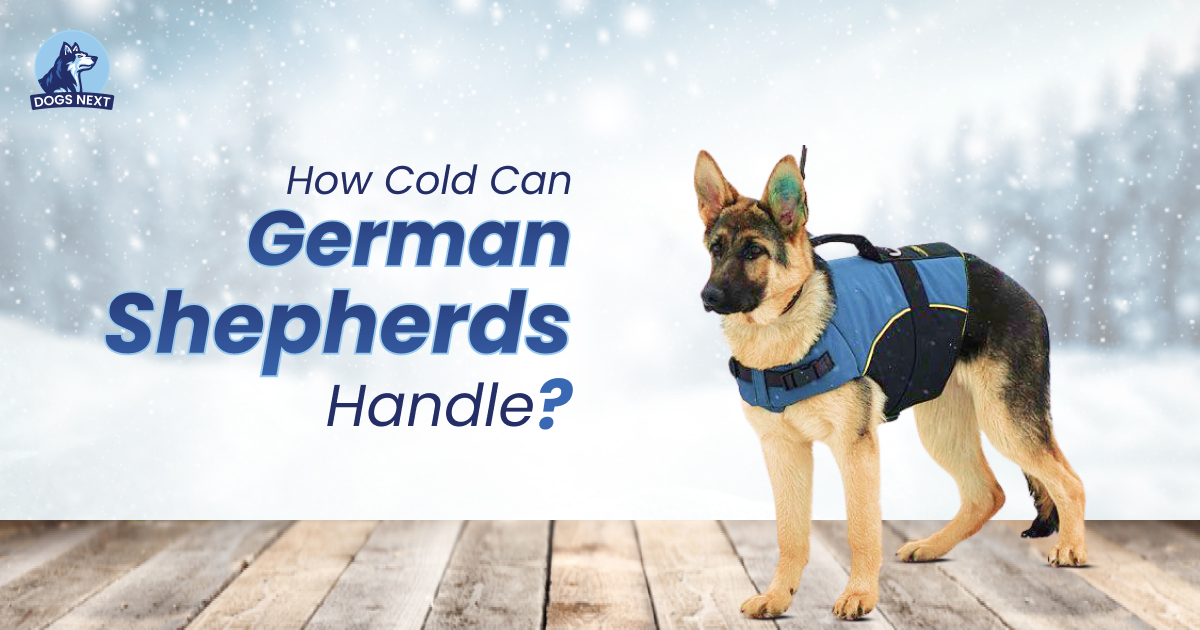German Shepherds are one of the most popular dog breeds in the world and for good reason. They are intelligent, loyal, and protective, making them excellent family pets and working dogs.
However, as with any breed, German Shepherds have unique characteristics that need to be considered when it comes to their health and well-being. One such characteristic is their cold weather tolerance.
As a general rule, adult German Shepherds can tolerate temperatures as low as 20 to 30 degrees Fahrenheit (-6 to -1 degrees Celsius) for short periods. They should never be left outside for extended periods in these temperatures, as they can still develop hypothermia or other cold-related health problems.
If you live in an area that experiences cold temperatures, it’s important to understand how your German Shepherd may be affected and how to keep them safe and comfortable. In this article, we will explore the cold weather tolerance of German Shepherds, the factors that affect it, and how to keep them warm in cold weather.
Understanding German Shepherds
German Shepherds are a large breed of dog that originated in Germany in the late 19th century. They were initially bred for herding sheep, but their intelligence and trainability have made them popular in a variety of roles, including police and military work, search and rescue, and as family pets. German Shepherds are known for their loyalty, courage, and protective instincts, as well as their athleticism and high energy levels.
Physical attributes that affect cold weather tolerance:
| Physical attribute | Description |
| Coat | German Shepherds have a thick, double coat that provides insulation against the cold. The outer coat is dense and waterproof, while the undercoat is soft and fluffy. |
| Size | German Shepherds are a large breed, with adult males weighing between 65-90 pounds and adult females weighing between 50-70 pounds. Their size can affect their ability to regulate body heat in cold weather. |
| Age | Young puppies and senior dogs may have a harder time regulating body temperature in extreme temperatures. |
| Activity level | Active dogs generate more body heat and may be able to tolerate colder temperatures for longer periods. |
What Temperature Can German Shepherds Tolerate?
The exact temperature that a German Shepherd can tolerate depends on a variety of factors, including age, health, coat thickness, and level of acclimation to cold weather.
Generally speaking, German Shepherds can handle temperatures as low as 20-30 degrees Fahrenheit for short periods. However, prolonged exposure to cold temperatures can be dangerous and may lead to hypothermia, a condition in which the body loses heat faster than it can produce it.
To ensure that your German Shepherd stays safe and comfortable in cold weather, it’s important to monitor their behavior and keep an eye out for signs of discomfort or distress. Some common signs of cold stress in dogs include shivering, lethargy, and reduced mobility.
Do German Shepherds Need Dog Coats in Winter?
Whether or not a German Shepherd needs a dog coat in winter depends on a variety of factors, including the temperature, the duration of exposure, and the individual dog’s tolerance for cold weather. In general, healthy adult German Shepherds with a thick coat of fur do not need a coat in moderately cold weather conditions.
However, if the temperature drops significantly or if the dog is exposed to cold weather for an extended time, a coat may be necessary to keep them warm and comfortable.
When choosing a coat for your German Shepherd, it’s important to consider their specific needs and preferences. Look for a coat that is warm, durable, and comfortable for your dog to wear. You may also want to consider a waterproof or water-resistant coat if your dog will be spending time in snow or wet conditions.
Finally, be sure to properly measure your dog and choose a coat that fits well and allows for the full range of motion.
Factors That Affect Cold Weather Tolerance in German Shepherds
When it comes to cold weather tolerance in German Shepherds, several factors come into play. These include:
Coat thickness and density: German Shepherds have a thick and dense double coat that helps them stay warm in cold weather. However, the thickness and density of the coat can vary depending on the individual dog.
Acclimation to cold weather: German Shepherds that live in colder climates may be more acclimated to the cold and may be able to handle lower temperatures than those that live in warmer climates.
Age and health of the dog: Older dogs and those with health issues may not be able to handle the cold as well as younger and healthier dogs.
Are German Shepherds a Good Cold Weather Dog Breed?
Overall, German Shepherds are a breed that can handle cold weather well. Their thick coats, high energy levels, and natural athleticism make them well-suited for cold-weather activities like hiking and playing in the snow.
However, it’s important to keep in mind that individual dogs may have different tolerances for the cold based on the factors listed above.
Signs to Watch Out for When Your German Shepherd is in the Cold
While German Shepherds can handle cold weather well, it’s important to keep an eye out for signs that your dog may be uncomfortable or even in danger. These signs include:
- Shivering
- Lethargy
- Decreased appetite
- Stiff or sore muscles
- Pale or blue gums
If you notice any of these signs in your German Shepherd, it’s important to take steps to warm them up and seek veterinary care if necessary.
Signs of Hypothermia in German Shepherds
Hypothermia is a serious condition that occurs when a dog’s body temperature drops below the normal range. It can be caused by prolonged exposure to cold weather, wet conditions, and wind chill. Here are some symptoms to watch for if you suspect your German Shepherd is experiencing hypothermia:
Symptoms to Watch for:
- Shivering
- Weakness and lethargy
- Rapid breathing and heart rate
- Pale gums
- Stiff muscles
- Decreased appetite
- Decreased urination and defecation
- Dilated pupils
What to Do if You Suspect Hypothermia:
If you suspect your German Shepherd is experiencing hypothermia, you should take immediate action to warm them up. Here are some steps you can take:
- Move your dog to a warm, dry area
- Cover your dog with a warm blanket or towel
- Use a hot water bottle or heating pad wrapped in a towel to warm your dog’s body
- Offer your dog a warm drink or broth to help raise their body temperature
- Monitor your dog’s temperature with a thermometer if possible
- If your dog’s condition does not improve or worsens, seek veterinary care immediately
Keeping Your German Shepherd Warm in Cold Weather
To prevent hypothermia and keep your German Shepherd comfortable in cold weather, it’s important to provide them with warm shelter and protective clothing. Here are some options to consider:
Indoor Shelter Options:
- Provide a warm, dry, and draft-free area in your home for your dog to rest in.
- Use a dog bed with a soft and warm blanket.
- Make sure the indoor temperature is set to a comfortable level for your dog.
Outdoor Shelter Options:
- Provide a sturdy and insulated dog house that is large enough for your dog to stand up, turn around, and lay down comfortably.
- Use straw or a warm blanket to line the dog house.
- Use a heated dog pad or a heated dog water bowl to keep your dog warm.
Protective Clothing and Gear:
- Use a dog coat or sweater to keep your dog’s body warm.
- Use booties to protect your dog’s paws from snow and ice.
- Use a hat or ear muffs to protect your dog’s ears from the cold.
By taking these steps to keep your German Shepherd warm and comfortable in cold weather, you can help prevent hypothermia and ensure that your dog stays healthy and happy.
Frequently Asked Questions
Q: How cold is too cold for a German Shepherd to be outside?
Ans: It depends on several factors such as acclimation to cold weather, coat thickness, and age. Generally, if the temperature drops below 20°F (-6°C), it’s too cold for a German Shepherd to stay outside for an extended period.
Q: Can German Shepherds sleep outside in winter?
Ans: While German Shepherds have a high tolerance for cold weather, it’s not recommended for them to sleep outside in winter. Provide indoor shelter options for your German Shepherd to keep them warm and comfortable during cold weather.
Q: Can German Shepherds survive in cold?
Ans: Yes, German Shepherds can survive in cold weather conditions, but they require proper acclimation, shelter, and protective clothing or gear.
Q: Is 20 degrees too cold for a German shepherd?
Ans: 20°F (-6°C) is on the threshold of what’s considered too cold for a German Shepherd to be outside for an extended period. Depending on other factors like acclimation, coat thickness, and age, it may or may not be too cold.
Q: What temperature is too cold for a German Shepherd puppy?
Ans: German Shepherd puppies are more susceptible to cold weather than adult dogs, and they have less developed immune systems. It’s recommended to keep them indoors if the temperature drops below 40°F (4°C).
Q: How cold is too cold for a German shepherd husky mix?
Ans: Like German Shepherds, German Shepherd Husky mixes can handle cold weather better than other breeds, but it’s still not recommended for them to stay outside for an extended period if the temperature drops below 20°F (-6°C). Provide them with proper shelter and protective clothing or gear.
Conclusion
In conclusion, German Shepherds are a breed that can tolerate cold weather to some extent, but it depends on various factors such as coat thickness, age, health, and acclimation to cold weather. While they may not need dog coats in winter, it’s important to provide them with proper shelter and protective gear if they spend time outside in cold temperatures.
As responsible pet owners, we should be aware of the signs of hypothermia and take steps to keep our furry friends warm and safe during the winter months. By understanding how cold German Shepherds can handle, we can ensure that our beloved pets are comfortable and healthy all year round.
So, always keep in mind to monitor your German Shepherd’s behavior and look out for any signs of discomfort in the cold.

I’m David, an expert contributor and writer, with two furry friends of my own, I know the challenges of raising and caring for dogs. From training to nutrition and health, my goal is to provide valuable insights and advice to help create strong bonds and happy, healthy lives. Find me in Twitter.




